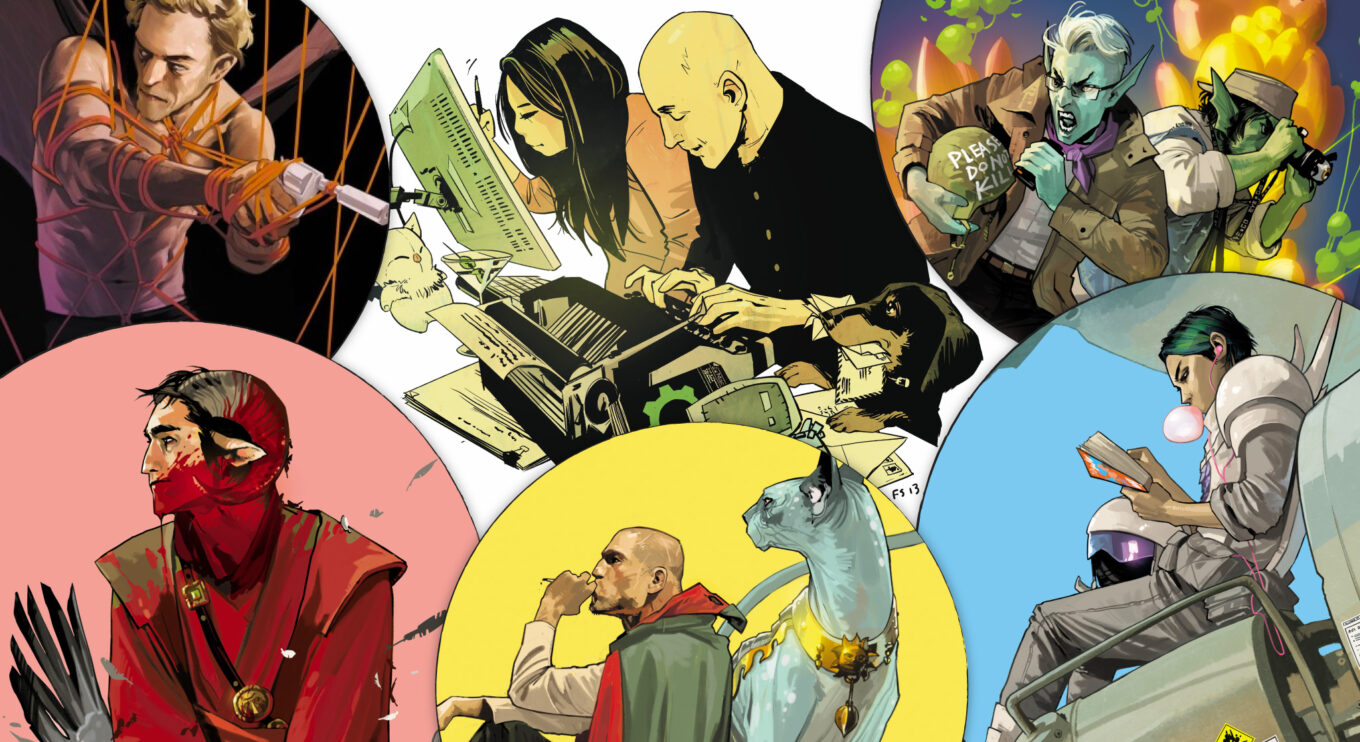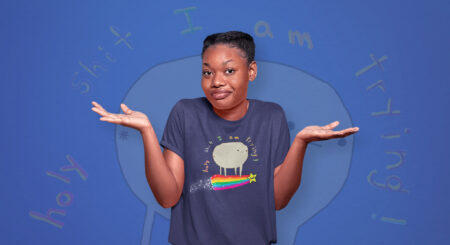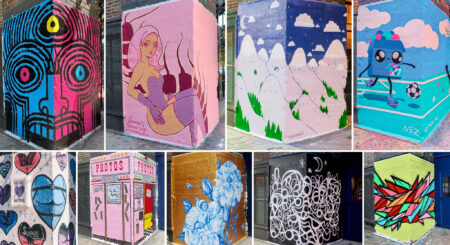In the illustrious cosmos of comic book storytelling, few series have resonated with the depth, ingenuity, and authenticity as the space opera epic, Saga. Conceived by the masterful partnership of writer Brian K. Vaughan and illustrator Fiona Staples, this tale has broken barriers, challenged conventions, and offered readers a refreshingly raw glimpse into the myriad complexities of relationships, parenthood, and survival amidst a galactic war.
With a reputation cemented by numerous accolades—including 12 Eisner Awards, 17 Harvey Awards, and the coveted 2013 Hugo Award for Best Graphic Story—the comic’s influence is indisputable. As we celebrate the release of the highly anticipated issue #66, another milestone coincides: the launch of the official Saga Threadless Artist Shop. Dive with us into this exclusive interview as Vaughan and Staples reflect on their journey, the making of their magnum opus, and offer a sneak peek into the exclusive merchandise that awaits fans in their shop. A universe of intrigue, artistry, and storytelling brilliance awaits!

Today marks the release of Saga #66, concluding the comic’s current story arc. After more than a decade’s worth of storytelling, how does it feel to have reached this milestone in the series?
Fiona Staples: To me it feels like the series has built up a ton of momentum, and I’m eager to roll onward! We’ve invested many years and many pages in these characters and have really gotten to know their personalities, their backstories, and their flaws. We’ve gradually established a fair bit of history and lore for the world they live in, too. And yet, I never feel as though we’ve painted ourselves into a corner because Brian is such a bold storyteller. No matter what the last 66 issues contain, anything will still be possible in issue 67.
Brian K. Vaughan: I can’t tell you how cool it is to still be collaborating with the same tight-knit band of creators who started this journey together back in 2011. And like a lot of my favorite issues, #66 sprung directly from a brilliant idea of Fiona’s. I’m so fortunate to get to make comics with awesome humans like her and Fonografiks, our loyal letterer.

The characters in Saga continue to face numerous challenges and conflicts as they navigate a war-torn galaxy. Brian, how do you approach the task of balancing the epic scope of the story with the intimate struggles of Alana, Marko, and their daughter, Hazel?
BKV: I always say that our war story is more Casablanca than Saving Private Ryan. I love a great battle scene, but human drama—particularly how even distant conflicts impact noncombatants—is what interests me most.
The artwork in this series is visually stunning, making it incredibly easy for readers to immerse themselves in the story. Fiona, can you talk about your artistic process and the challenges and rewards of bringing the world of Saga to life through illustrations?
FS: Thank you! My goal is to make Saga easy to read. I want readers to be able to parse the story and the action even when presented with the weirdest scenarios, like a moon-sized space fetus shooting goo from its eyes. So the most important part of my process is the thumbnails, where I design the page layouts and stage everything. After that’s done, I digitally ink the figures and paint the backgrounds in Clip Studio and Photoshop. And when I feel a joke or a shocking reveal really lands, it’s very rewarding.
Earlier in the series, there’s a funny moment when cyclops novelist D. Oswald Heist admits that he’s hesitant to collaborate with artists because they frighten him. As co-creators who’ve proven to be an all-star pairing, what has been the best part of working together on Saga?
FS: There are two best parts. How good Brian is at doing this, and how thoroughly decent he is as a person. It’s been over a decade and I’m somehow still resentment-free and thrilled to be working together.
BKV: That’s the nicest thing anyone has ever said about me. Fiona is obviously one of the greatest visual artists alive, yet she’s also unbelievably kind, humble, and constantly pushing herself and her art to impossible new heights. I wish I could be her when I grow up.

You depict parenthood in various forms beyond the traditional nuclear family. Brian, how important was it for you to showcase diverse parenting experiences, and what message does it convey to readers?
BKV: I hope our comics don’t convey any messages! That sounds a little “After-School Special” to me. I just like to write imaginative stories inspired by the kinds of families and relationships I see in my real life, almost none of which are “traditional.”
Fiona, your imaginative character designs are so vital to the story’s world-building that they’ve even influenced the direction of the narrative. How do you come up with such wildly different creatures? And why is Ghüs so damn cute?!
FS: There’s usually a description, or at least a seed of one, of each character when they’re introduced in the script, so I just take Brian’s directions and run with them. The aim is to make each one unique since we have such a large ensemble of characters. If we’ve already done an owl doctor, the next doctor better be a bear.
Which Saga character do you most relate to and why?
FS: Probably Doff, just trying to make pictures and do the right thing and have a nice time.
BKV: Hm, this is a tough one. There are things I love and hate about each of our characters… but I guess I’d say I’ve always most related to Alana. Not sure why, but her voice is just the easiest for me to hear.

Brian, as a father yourself, how have your personal experiences with parenthood influenced your storytelling in Saga? Are there any specific moments or themes that you drew from your own life?
BKV: Nearly every panel of every page has been somehow inspired by (read: stolen from) my children. It’s gotten to the point that whenever something fascinating/traumatic/pivotal happens to our family, my wife and kids start guessing how I’ll exploit it for future issues of Saga.
The environments and planetary settings in Saga are incredibly diverse. How do you go about conceptualizing and illustrating these fantastical landscapes, and do you have any favorite settings from the series?
FS: Airland, the abandoned theme park on Jetsam where we spent Volume 9, was one of my favorites. For inspiration I got to look at real amusement parks and resorts that were overtaken by nature. They have a neat surreal feel. I like being able to take familiar real-world settings like strip malls or record shops and make them a bit fantastical.
Many comic book series have been adapted into successful TV shows or movies, but in the past, you’ve both expressed not wanting to pursue those types of adaptations for Saga. How does the comic medium uniquely suit the story you want to tell?
FS: In comics we’re able to depict anything the story calls for without concern for “realism,” since cartooning is inherently unrealistic and asks the reader’s imagination to bring life and motion to the pages. We can get away with a lot of imagery that would be harder to pull off in a less interactive medium. Comics give us a lot of grace.
BKV: I actually really like adaptations! I’ve been lucky enough to both have been adapted and to have helped adapt others… but when it comes to Saga, I love that readers of our comic aren’t passive audience members but active collaborators. And even more than the proverbial “unlimited special effects budget” that comics offers, the medium also allows us to explore themes and imagery that many mainstream films and TV shows can’t.

This series has been celebrated for pushing boundaries in its storytelling, particularly in how it portrays issues relating to ethnicity, sexuality, and gender roles. Were there any risks you took that you were initially unsure about, but ultimately felt were essential to the narrative?
BKV: Never the sexual content—since I know Fiona has a way of making even my most perverse suggestions beautiful to behold—but I do give a lot of thought to the use of certain words, particularly with this most-recent storyline. I guess you could say that language has become a slightly more “risky” area for writers of recent, but It’s definitely been essential to the story we’re telling from the very beginning.
This series has given you opportunities to illustrate some pretty wild moments (I’m thinking of a particular dragon in a cave). While drawing scenes like these, do you ever laugh and think about how weird your job gets?
FS: I don’t understand why we’re allowed to print this filth, but I live for it.
Today, we’re also celebrating the launch of the Saga merch store at Threadless Artist Shops. What designs and products in your shop are you most excited about?
FS: I’m a fan of in-universe merch, so I was excited to slap the Douglass L. Zaapy’s Rave-taurant logo on a shirt! I spent way too much time on it for something we only see in one panel…
BKV: Yeah, I similarly love “deep cuts” like The Mistook and Tooty Stinkfoot. It’s all so excellent.

Thank you both for this illuminating interview! Is there any message you’d like to share with Saga fans?
FS: Just a big thank you for reading!
BKV: And we greatly appreciate their patience!

As we look ahead with bated breath for Saga’s next chapters, let’s not forget the monumental present. Grab your copy of issue #66 today and head to the official Saga Threadless Artist Shop for exclusive merchandise. We extend a heartfelt thanks to Brian K. Vaughan and Fiona Staples for this interview, and for giving us a world that continually inspires and astonishes!





